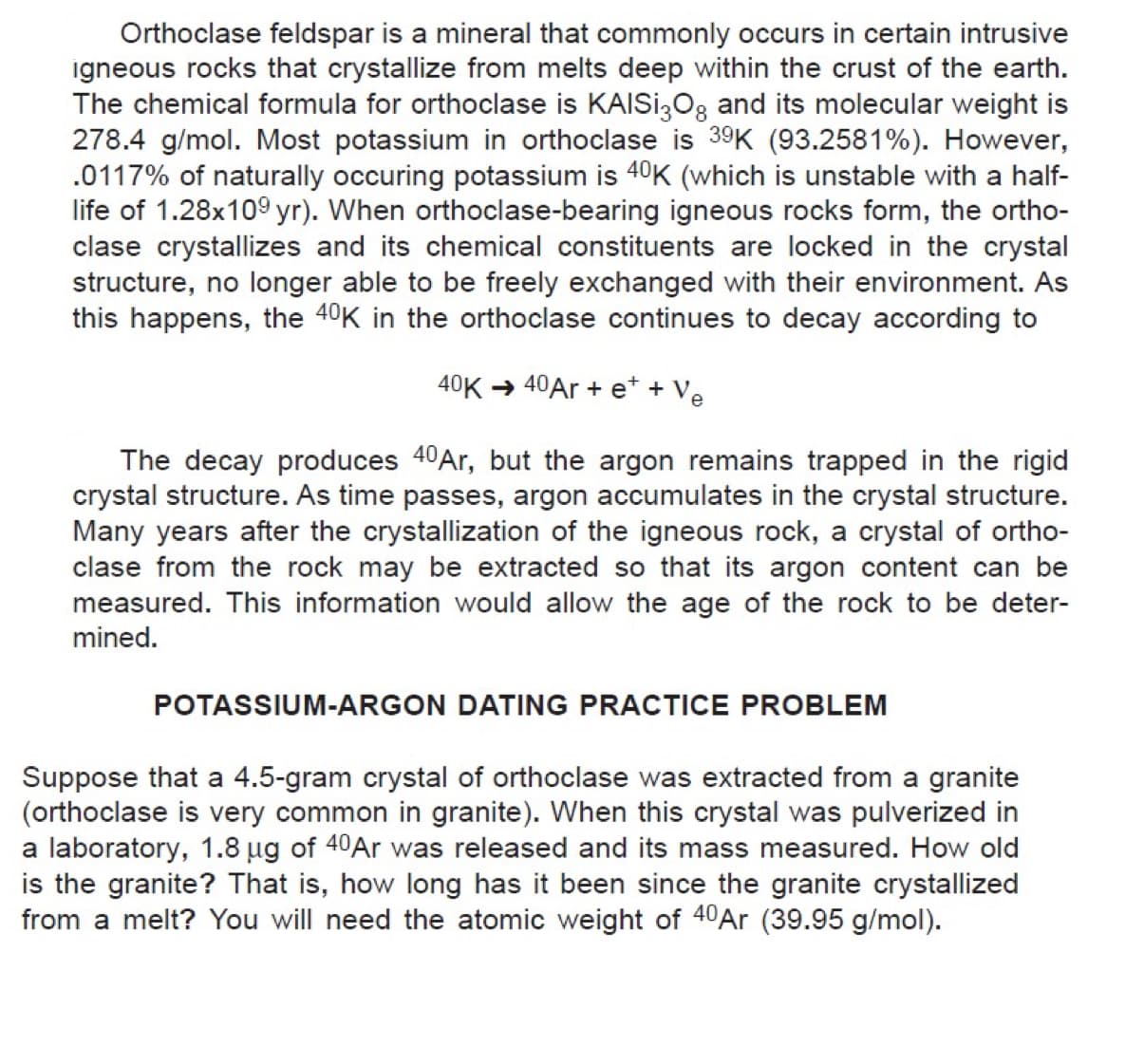Orthoclase feldspar is a mineral that commonly occurs in certain intrusive igneous rocks that crystallize from melts deep within the crust of the earth. The chemical formula for orthoclase is KAISİ3O3 and its molecular weight is 278.4 g/mol. Most potassium in orthoclase is 39K (93.2581%). However, .0117% of naturally occuring potassium is 40K (which is unstable with a half- life of 1.28x109 yr). When orthoclase-bearing igneous rocks form, the ortho- clase crystallizes and its chemical constituents are locked in the crystal structure, no longer able to be freely exchanged with their environment. As this happens, the 40K in the orthoclase continues to decay according to 40K → 40Ar + e* + Ve The decay produces 40Ar, but the argon remains trapped in the rigid crystal structure. As time passes, argon accumulates in the crystal structure. Many years after the crystallization of the igneous rock, a crystal of ortho- clase from the rock may be extracted so that its argon content can be measured. This information would allow the age of the rock to be deter- mined. POTASSIUM-ARGON DATING PRACTICE PROBLEM Suppose that a 4.5-gram crystal of orthoclase was extracted from a granite (orthoclase is very common in granite). When this crystal was pulverized in a laboratory, 1.8 ug of 40Ar was released and its mass measured. How old is the granite? That is, how long has it been since the granite crystallized from a melt? You will need the atomic weight of 40Ar (39.95 g/mol).
Orthoclase feldspar is a mineral that commonly occurs in certain intrusive igneous rocks that crystallize from melts deep within the crust of the earth. The chemical formula for orthoclase is KAISİ3O3 and its molecular weight is 278.4 g/mol. Most potassium in orthoclase is 39K (93.2581%). However, .0117% of naturally occuring potassium is 40K (which is unstable with a half- life of 1.28x109 yr). When orthoclase-bearing igneous rocks form, the ortho- clase crystallizes and its chemical constituents are locked in the crystal structure, no longer able to be freely exchanged with their environment. As this happens, the 40K in the orthoclase continues to decay according to 40K → 40Ar + e* + Ve The decay produces 40Ar, but the argon remains trapped in the rigid crystal structure. As time passes, argon accumulates in the crystal structure. Many years after the crystallization of the igneous rock, a crystal of ortho- clase from the rock may be extracted so that its argon content can be measured. This information would allow the age of the rock to be deter- mined. POTASSIUM-ARGON DATING PRACTICE PROBLEM Suppose that a 4.5-gram crystal of orthoclase was extracted from a granite (orthoclase is very common in granite). When this crystal was pulverized in a laboratory, 1.8 ug of 40Ar was released and its mass measured. How old is the granite? That is, how long has it been since the granite crystallized from a melt? You will need the atomic weight of 40Ar (39.95 g/mol).
Related questions
Question

Transcribed Image Text:Orthoclase feldspar is a mineral that commonly occurs in certain intrusive
igneous rocks that crystallize from melts deep within the crust of the earth.
The chemical formula for orthoclase is KAISİ3O3 and its molecular weight is
278.4 g/mol. Most potassium in orthoclase is 39K (93.2581%). However,
.0117% of naturally occuring potassium is 40K (which is unstable with a half-
life of 1.28x109 yr). When orthoclase-bearing igneous rocks form, the ortho-
clase crystallizes and its chemical constituents are locked in the crystal
structure, no longer able to be freely exchanged with their environment. As
this happens, the 40K in the orthoclase continues to decay according to
40K → 40Ar + e* + Ve
The decay produces 40Ar, but the argon remains trapped in the rigid
crystal structure. As time passes, argon accumulates in the crystal structure.
Many years after the crystallization of the igneous rock, a crystal of ortho-
clase from the rock may be extracted so that its argon content can be
measured. This information would allow the age of the rock to be deter-
mined.
POTASSIUM-ARGON DATING PRACTICE PROBLEM
Suppose that a 4.5-gram crystal of orthoclase was extracted from a granite
(orthoclase is very common in granite). When this crystal was pulverized in
a laboratory, 1.8 ug of 40Ar was released and its mass measured. How old
is the granite? That is, how long has it been since the granite crystallized
from a melt? You will need the atomic weight of 40Ar (39.95 g/mol).
Expert Solution
This question has been solved!
Explore an expertly crafted, step-by-step solution for a thorough understanding of key concepts.
This is a popular solution!
Trending now
This is a popular solution!
Step by step
Solved in 4 steps with 6 images
